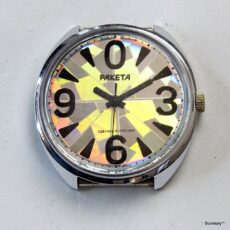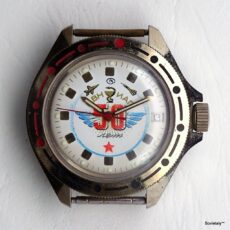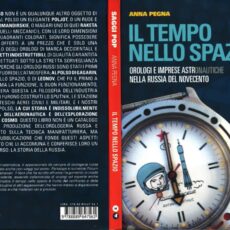Among Russian watches, the Vostok Desert Shield stands out as a hero of numerous urban legends, misunderstandings, stories, and fictional anecdotes. Below, we explore the history and various versions of this iconic watch.
Origins and Creation
The American newspaper Beverly Times mentions the birth of the Vostok Desert Shield on January 28, 1991. The article, likely an advertorial, highlights Bruce Erikson, an American businessman who had the idea of importing “Made in the USSR” watches to the United States. Erikson founded Timepeace Russian Watches Inc. in 1990, commissioning the Vostok factory in Chistopol to produce 10,000 watches to commemorate Operation “Desert Shield” during the Gulf War.
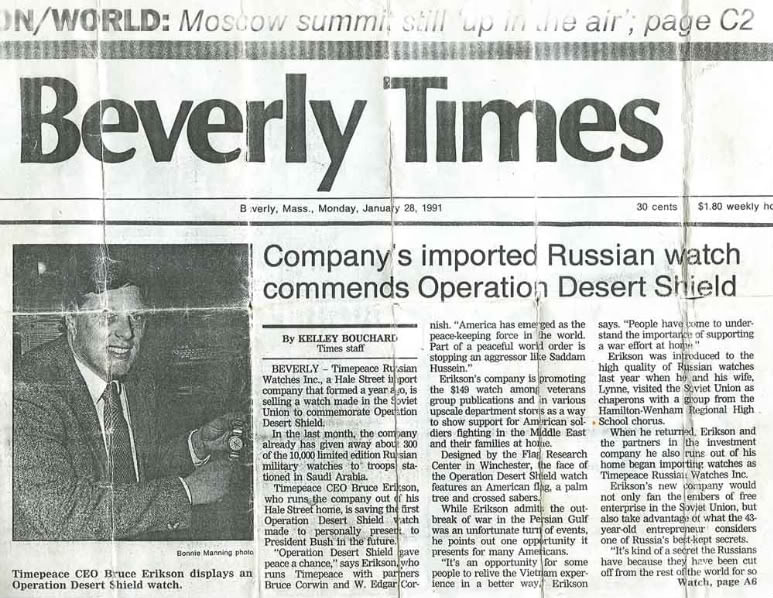
The Flag Research Centre worked on the dial image, creating the famous design that combined the American flag with a palm tree and two green Arabian sabres, in homage to the Kingdom of Hejaz and the Sultanate of Nejd, united in 1932 to become Saudi Arabia. Erikson also intended to send a watch to President Bush. These watches were not intended for American soldiers serving during the Gulf War; the entire initiative was purely commercial.
Production Details and Various Versions
It seems that the actual production increased to 40,000 units, divided into several series worth distinguishing and analyzing.
First Series
The first series of the Desert Shield is recognizable by the absence of the Vostok B logo on the dial, with the inscription “Made in USSR.” The case is the 420 Amphibian, combined with a bezel with a luminous dot at 12, four small red dots, and seven black dots. The hands are those of the Amphibia, with the seconds hand red and a luminous “lollipop.”
The Timepeace logo is engraved on the case back, which also bears the words “VOSTOK,” “Series I,” “USSR,” “Self Winding,” “SS Case,” “Watertight 200m,” “21 jewels,” and a five-digit serial number. The movement is an automatic Vostok 2416B, with the words “twenty-one” and “21 jewels” written in black on the oscillating weight.
The watch was sold for $149, with a discount for military personnel at $99. It was sold with documents in English, suggesting it was intended for the American market, supporting the idea that it was not a military watch but an accessory available in outlets.
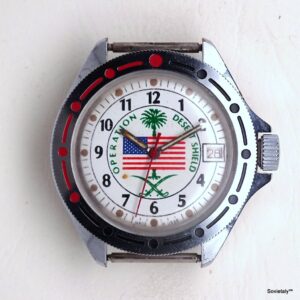
Second Series
This version had an identical dial to the first series but some differences. The case remained the 420 steel model, but the coordinated bezel became the standard Amphibia one, with slightly larger red dots.
The case back had the Timepeace logo and the inscriptions “VOSTOK” or “VREMIR,” “USSR,” “Self-Winding,” “SS Case,” “Watertight 200m,” “21 jewels,” and a six-digit serial number. The movement remained the automatic 2416B, with the inscriptions “twenty-one” and “21 jewels” not in black.
When we talk about the possibility of finding the VOSTOK or VREMIR logo on the case back, we should add that “VREMIR” combines two words: “VREMIA” (time) and “MIR” (peace). “Vremir” was a registered trademark of Timepeaces Russian Watches Inc. in 1991. This detail on the case back is a sort of nod to the company’s name.
This series also had documents in Russian, indicating they were sold both in the United States and in Russia. The number of units produced remains unknown.
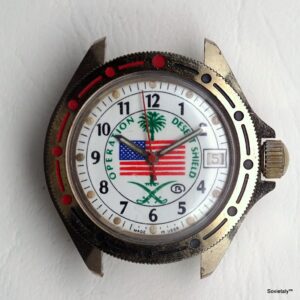
“Cadet” Model
Another popular model is the 34 mm Cadet model, distinctive for the inscription on the dial “Desert Shield” on the left semicircle and “Desert Storm” on the right semicircle, instead of “Operation Desert Shield,” indicating a design developed after 1991.
The case is the “Cadet” model, measuring 34 mm, with spear-shaped hands for the hours and minutes. The movement is the 2409A, 17 jewels with manual winding. The case back bears the Timepeace logo and the words “Vremir,” “USSR,” “Watertight 50m,” “17 jewels,” “Shockproof,” “SS back,” and a six-digit serial number.
This model often appears in small cases with standard Vostok case backs and is included in a 1993 Vostok catalog.
Other Versions
Browsing the internet or exploring flea markets, you can find Vostok Desert Shield watches with variations from the described models. These might have different case backs, more similar to standard Vostok designs, or dials with the Vostok “B” logo. It is believed that Vostok had a surplus of dials and assembled watches using different Komandirskie or Amphibia cases from the 420. These versions featured the “B” logo and used different cases or movements depending on the period.
Vympel Version
A very special version of the Desert Shield is known with the inscription Alcor Vostok (Алькор Восток) on the case back, a model that at first glance might seem like a fake made with a standard Chinese Tongji calibre, but several elements suggest authentic production, albeit bizarre.
This model is often attributed to the Belarusian factory Vitebsk Instrument-Making Plant, known for using standard Chinese Tongji calibres for its production. The attention to detail and the presence of Vostok logos on the calibre, dial, and case back suggest that, for some particular reason, the production was requested by Vostok. The case design suggests a Vympel, a brand that often used standard Chinese Tongji calibres for its production.
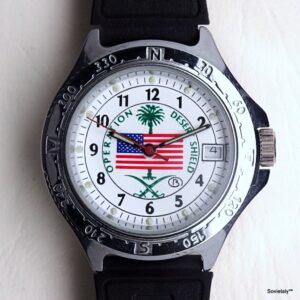
Modern Versions and Legacy
The Vostok Desert Shield has been honoured several times, with modern and contemporary models updated following new Vostok productions. The museum in Chistopol, where the Vostok factory is located, displays two examples of the Desert Shield, indicating its historical and commercial importance.
Despite its commercial origins, the Vostok Desert Shield is a fascinating artefact, reflecting a combination of history, marketing, and craftsmanship. Its history, linked to the Gulf War and the cultural exchange between the USA and the USSR, continues to capture the attention of watch enthusiasts and collectors worldwide.
Faithful Transcript of the Article
Beverly, Mass, Monday, January 28, 1991
Company’s imported Russian watch commends Operation Desert Shield
By KELLEY BOUCHARD
Times staffBEVERLY – Timepeace Russian Watches Inc., a Hale Street inport company that formed a year ago, is selling a watch made in the Soviet Union to commemorate Operation Desert Shield.
In the last month, the company already has given away about 300 of the 10,000 limited edition Russian military watches to troops stationed in Saudi Arabia.
Timepeace CEO Bruce Erikson, who runs the company out of his Hale Street home, is saving the first Operation Desert Shield watch made to personally present to President Bush in the future.
“Operation Desert Shield gave peace a chance,” says Erikson, who runs Timepeace with partners Bruce Corwin and W. Edgar Cornish. “America has emerged as the peace-keeping force in the world. Part of a peaceful world order is stopping an aggressor like Saddam Hussein.”
Erikson’s company is promoting the $149 watch among veterans group publications and in various upscale department stores as a way to show support for American soldiers fighting in the Middle East and their families at home.
Designed by the Flag Research Center in Winchester, the face of the Operation Desert Shield watch features an American flag, a palm tree and crossed sabers.
While Erikson admits the outbreak of war in the Persian Gulf was an unfortunate turn of events, he points out one opportunity it presents for many Americans.
“It’s an opportunity for some people to relive the Vietnam experience in a better way,” Erikson says. “People have come to understand the importance of supporting a war effort at home.”
Erikson was introduced to the high quality of Russian watches last year when he and his wife, Lynne, visited the Soviet Union as chaperons with a group from the Hamilton-Wenham Regional High School chorus.
When he returned, Erikson and the partners in the investment company he also runs out of his home began importing watches as Timepeace Russian Watches Inc.
Erikson’s new company would not only fan the embers of free enterprise in the Soviet Union, but also take advantage of what the 43-year-old entrepreneur considers one of Russia’s best-kept secrets.
It’s kind of a secret the Russians have because they have been cut off from the rest of the world for so long.
Beverly, Mass, Monday, January 28, 1991

